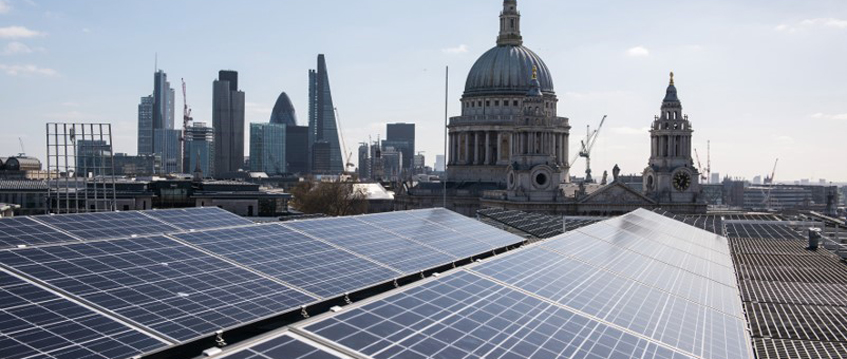On 7 April, the government unveiled its new energy strategy aimed at boosting energy security and independence in the UK.
The strategy set out the ambitious expansion of technologies such as wind, solar, hydrogen and new nuclear, which could see 95% of Great Britain’s electricity generated by low-carbon technologies by 2030. Offshore wind is set to deliver 50GW of power – including 5GW of floating offshore wind by 2030 and, while no specific targets were set for solar, an increase of five times the current capacity (14GW) by 2030 could equate to approximately 70GW of ground-mounted and rooftop solar generation capacity.
One of the potential gaps in the strategy was the utilisation of onshore wind. The hoped-for changes to planning law enabling full-scale deployment in England were replaced with a promise to consult on developing partnerships with a limited number of communities. The need for a more robust and improved grid was also mentioned, but further clarification and defined targets regarding the role of large-scale and long-duration electricity storage would have been welcome. Lastly, the strategy highlighted the government’s aim to double its ambition of 10GW of low-carbon hydrogen production capacity by 2030 but did not pinpoint the longer-term role of hydrogen.
For the energy sector, its role in the journey to net zero is clearly defined and while further consultation will shape what the deployment of these technologies will look like, the basic roadmap is there.
The energy strategy
Sustainability and ESG are driving corporate decision-making and, for investors, owners and occupiers in the commercial real estate sector, these factors are shaping the demand for “green buildings” – both new build and retrofit. We are seeing a sharp spike in the demand for green buildings which will support an occupier’s sustainability and ESG credentials; the knock-on effect of this being increased rental premiums and investor interest.
The expectations of a green building, however, extend beyond just the building’s EPC rating. Alongside increased amenities such as flexible working spaces, breakout areas, on-site gyms, cafés and e-bike and electric vehicle charging infrastructure – which support sustainability, mental health and wellbeing requirements – the building also needs to provide green energy. This is where the energy strategy will have a direct impact.
Green energy is an easy way for occupiers to reduce their carbon footprint, and where an organisation has set a more formal target for achieving net zero emissions, being able to source green energy will be an essential part of this. In short, this means switching to energy generated by renewable sources such as wind or solar power. This could be as simple as using a green energy supplier, but both in the context of a new build or retrofitting to “green” the building, the owner or developer may wish to take this a step further.
For example, when installing e-bike or EV charging infrastructure which needs to be powered by green energy, it would be worth looking at installing on-site generation or entering into a corporate power purchase arrangement with an off‑site generator.
Powering green buildings
The fivefold increase in solar and the consultation to simplify the planning process for rooftop solar opens up potential avenues for on-site generation. The owner (or occupier in conjunction with the owner) may look to take on the design, build, operation and maintenance of their own portfolio of clean energy assets. Depending on the nature of the building, that could be a combination of solar panels on the roof and energy storage – providing the building with green power and powering associated charging infrastructure.
An alternative would be to enter into a concession-type arrangement whereby the company procures energy services from a third party via private wire generation. Another option is a corporate power purchase arrangement with an off-site generator. In practice, these powering solutions in England tend to be generated by ground-mounted solar or ground-mounted solar plus storage. For example, the City of London Corporation signed a PPA with Voltalia, under which it will buy all of the energy produced from a new-build solar farm for the next 15 years.
The ambition to scale solar up to 70GW, alongside further consultations to amend the planning rules for ground-mounted solar and the support for solar which is co-located with other technologies such as storage, is going to increase the development of solar projects in what is already a buoyant market. More projects mean more opportunities for green buildings to access green power. We have already seen a rise in corporate PPAs, with Barclays being one of the latest businesses to enter into a 10-year corporate PPA, and would expect to see more corporate PPAs and private-wire arrangements in the coming months.
What’s next?
Providing green power is essential, but every building will be different. For new buildings, developers are guided by planning policy, which takes a fabric-first approach to energy efficiency, with on-site renewable generation being used wherever possible and offsets making up the rest of the contribution.
Retrofit buildings will need to find the right arrangement and a bespoke balance of technologies. This could involve a combination of some of the various options outlined above, rather than a single solution or a one-size-fits-all approach. Collaboration with the building’s occupiers will be central to establishing the right solution and answering the key question of “who pays?”.
Regardless of the solution, the energy strategy could present a real opportunity for the commercial real estate sector to provide green buildings with green power, and help drive the nation towards achieving its net zero targets.
Maria Connolly is a partner and head of clean energy and real estate at TLT










